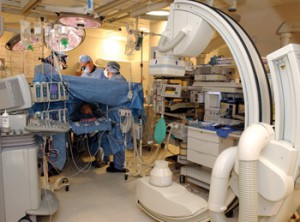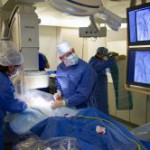 The hybrid operating room is both a fully equipped surgical suite and a state-of-the-art cardiac catheterization laboratory in the same room. This “Hybrid OR” is a place where cardiac surgeons and interventional cardiologists work side by side in order to achieve an optimal result for the patient. Until now, patients needing both procedures would have bypass surgery first and then angioplasty a day or two later or the reverse.
The hybrid operating room is both a fully equipped surgical suite and a state-of-the-art cardiac catheterization laboratory in the same room. This “Hybrid OR” is a place where cardiac surgeons and interventional cardiologists work side by side in order to achieve an optimal result for the patient. Until now, patients needing both procedures would have bypass surgery first and then angioplasty a day or two later or the reverse.
The hybrid procedure is an innovative approach to double- or triple-vessel coronary artery disease. The hybrid approach combines minimally invasive coronary artery bypass surgery (TECAB or MIDCAB) with catheter-based coronary intervention.
The rationale for this approach is that the internal mammary artery, which can be placed in minimally invasively, is the best choice for the anterior wall of the heart. Under protection of this bypass graft the other vessels are stented.
When the bypass surgery is complete, an interventional cardiologist takes over with angioplasty to restore normal blood flow in arteries not blocked enough to require a bypass. To reduce the chance that the blockage will recur, coated stents are used. The stents are coated with a medication that prevents reblocking, also known as restenosis.
Although the procedures are not new, the fact that they are combined is. The hybrid procedure combines the best of both worlds — bypass surgery and stenting — by using a minimally invasive surgical procedure that has longevity and using stents for what they are best at, which is taking care of non-left anterior descending (LAD) vessels.
procedures are not new, the fact that they are combined is. The hybrid procedure combines the best of both worlds — bypass surgery and stenting — by using a minimally invasive surgical procedure that has longevity and using stents for what they are best at, which is taking care of non-left anterior descending (LAD) vessels.
The team at the University is working on advanced hybrid procedures in which multiple blockages of the coronary artery system are treated using a combination of endoscopic surgery and catheter-based intervention.
What are the other advantages of the simultaneous hybrid procedure?
- This approach benefit patients because it is more convenient and less stressful to have both bypass surgery and stenting performed at the same time, rather than on separate days.
- The procedure is carried out with the complete safety net of a cardiac surgery operating room.
- This type of bypass surgery can be performed without a major incision. It’s a less invasive procedure with improved chances for long-term success.
- Patients can also expect quicker recovery times and reduced hospital stays.
Who is a good candidate for the hybrid procedure?
Ideal candidates for the hybrid procedure have a blockage in a major vessel called the left anterior descending (LAD) artery, which supplies 60 percent of the blood to the heart, as well as blockages in non-LAD arteries that can be treated with a stent.
Why should patients come to Safemedtrip Hospitals?
Safemedtrip Hospitals in India do the combined procedure in the same operating room and the doctors have played a pioneering role in this area.
The hybrid operating room is both a fully equipped surgical suite and a state-of-the-art cardiac catheterization laboratory in the same room.
This combined OR presents a tremendous advantage, because if for some reason doctors are unable to get a satisfactory result from the angioplasty side, then they can convert to an open bypass operation. The patient won’t have to be moved to another room because they will already be in an operating room, which is equipped with a heart-lung machine. The hybrid operating room is a high-tech treatment unit that is regarded as the operating room of the future.
The Hospitals are proud of having surgeons and interventional cardiologists who cooperate in order to obtain a perfect therapy concept for the patient.
For more information on Minimal Invasive Heart Surgery please visit this link: https://safemedtrip.com/medical-services/heart-surgery-in-india.html

 Click to WhatsApp
Click to WhatsApp +91-9899993637
+91-9899993637



